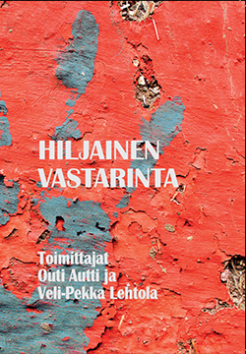Hiljainen vastarinta

Tiedostolataukset
Avainsanat:
vastustus, vastarinta, passiivinen vastarinta, arki, saamelaiset, sotavangit, inkeriläiset, nuoret, koulukodit, yrittäjyys, joukkueurheilu, partisaanit, jatkosota, vähemmistöt, historia, sukupuoliroolit, rokotevastaisuus, identiteettiTiivistelmä
Kirja tekee näkyväksi vähän käsiteltyä hiljaisen vastarinnan ilmiötä sekä kokoaa yhteen ja esittelee sitä koskevaa tutkimusta. Kun ihmisen toimintaa säädellään, hallitaan tai kontrolloidaan, ilmenee usein myös avointa vastarintaa, jota on tutkittu esimerkiksi demokratian toteutumisen, kansalaistottelemattomuuden tai poliittisen aktivismin näkökulmista. Valta-asetelmiin ja konflikteihin voi kuitenkin liittyä myös toisenlaista vastarintaa, jota ei välttämättä ensin edes huomata vastarinnaksi. Sitä voidaan kutsua hiljaiseksi, passiiviseksi, näkymättömäksi tai arkipäivän vastarinnaksi. Hiljainen vastarinta on alistettujen tai muuten marginaalisiksi jääneiden tapa asettua poikkiteloin hallitsevien sääntöjen tai järjestelmien kanssa. Koska se ei julistaudu vastarinnaksi, vaan pikemminkin pyrkii pysymään poissa julkisuudesta, se on riskitöntä matalan profiilin toimintaa, joka on näennäisesti epäpoliittista ja josta ei jää kiinni.
Hiljainen vastarinta voi saada monia erilaisia muotoja: se saattaa näyttäytyä esimerkiksi vaikenemisena ja jurnuttamisena, ulkopuolelle jättäytymisenä, asioiden välttämisenä, niiden vaikeuttamisena tai huomion siirtämisenä epäolennaiseen. Arkipäivän vastarinnan merkitys nousee pienten verkostojen signaaleista tilanteessa, jossa ei kyetä tai haluta lähteä julkiseen vastakkainasetteluun, mutta ei myöskään haluta pysyä täysin passiivisina. Marginaaliin jäävää hiljaista vastarintaa ei myöskään voida nähdä erillisenä avoimesta vastarinnasta, vaan se on tärkeä osa avoimemman vastarinnan aktualisoitumisen prosessia. Vaikka valtasuhteet toimivat ilmiön tapahtumakehyksinä, hiljainen vastarinta ei ole ainoastaan alistettujen toimintaa. Sen taktiikoita voivat käyttää myös valtaapitävät.
Kirjan artikkeleiden mukana pääsemme seuraamaan mitä moninaisimpia hiljaisen vastarinnan tapahtumatilanteita sekä historiallisten että nykypäivän tapahtumien avulla. Erilaiset tapaukset avaavat ja jäsentävät hiljaisen vastarinnan esiintymismuotoja, samoin kuin sen mekanismeja ja motiiveja. Kokoelman artikkeleissa tulevat esiin sosiologian, kulttuuriantropologian, kulttuurintutkimuksen, nuorisotutkimuksen ja historian-tutkimuksen näkökulmat. Tämä korostaa hiljaisen vastarinnan laajaa kirjoa, sen äänekkyyttä ja monialaisuutta.
Sisällys- Jurnutuksen käsikirja / Veli-Pekka Lehtola ja Outi Autti
- Tekemättä jättämiset vastarintana / Kaisa Kärki
- Konfliktien välttelyä ja piiloon hakeutumista: Rokotekriittisten vanhempien vastustustaktiikat / Johanna Nurmi ja Suvi Salmenniemi
- ”Lappalainen on kaukaa ovela ja laskelmallinen”: Saamelaisten arkipäivän vastarinta E.N. Mannisen teoksissa / Veli-Pekka Lehtola
- Vihollinen saa kasvot: Neuvostosotavangit suomalaisilla maatiloilla / Outi Autti ja Marjo Laitala
- Neuvostovaltaa vastaan: Inkerinsuomalaisten hiljaista vastarintaa 1930-luvulla / Anni Reuter
- Marginaalien vaiennettu vastarinta: Tutkimus nuorista kahdessa laitoksessa / Veronika Honkasalo ja Elina Pekkarinen
- Yhteiskunnallinen yrittäjyys ja itsensätyöllistäminen hiljaisena vastarintana / Eeva Houtbeckers
- Vastarinnan mitalla: Roller derby kilpaurheilun järjestyksiä haastamassa / Anni Rannikko, Päivi Armila, Veli Liikanen ja Pasi Torvinen
- Omapäisesti laitosvaltaa vastaan / Marjo Laitala
- Unohtamista uhmaten: Partisaanisodan muistelukulttuuri hiljaisena vastarintana / Kirsi Laurén
- Vähemmistöjen kulttuuriautonomialakiin kohdistunut vastustus Virossa 1918–1925 / Kari Alenius

Tiedostolataukset
Julkaistu
Kategoriat
Lisenssi

Tämä työ on lisensoitu Creative Commons Nimeä-EiKaupallinen-EiMuutoksia 4.0 Kansainvälinen Julkinen -lisenssillä.







